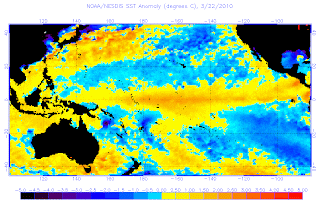Vagaries© of the weather.blog written by rajesh kapadia & co-authors concentrating on meteorology of the Indian sub continent and extreme world weather since 55 years For Any Information taken from here, due credit must be given to Vagaries.
Co Authors: GSB, Shreyas Dhavale, Pradeep John, Dr. Vineet Singh, Gokul
Tuesday, March 23, 2010
A quick look at the current El-Nino position: Active and persistent.
The Monthly SOI from May to Dec 2009, is -5.1, -2.3, 1.6, -5.0, 3.9, -14.7, -6.7, -7.0, and for the JAN/FEB 2010 -10.1, -14.5.
Negative figures in June, and August last year indicate the emerging El-Nino. Now, the 30-day Southern Oscillation Index [SOI] to 20 March was -10.
What we need a positive SOI from May onwards for a healthy monsoon.
Normally, regions affected by El Nino weather pattern are Myanmar, Laos, Thailand, Vietnam, Cambodia, Singapore, northern Sumatra, Sarawak and Sabah.
India 's monsoon link to El-Nino has never been proved. But I would say for certain that all drought years were El-Nino years,though all El-Nino years did not prove drought years. Sure, El-Nino years did give sparse rains and a deficit monsoon.
The typical impacts of El Nino over the Southeast Asian region come in the form of unusual and prolonged dry conditions: this is particularly the case in the Indonesia region and Borneo Island.
Even though El Nino started sometime duringJune 2009 as announced by established global climate centres, the periodic dry of the weather continues into Feb 2010.It is forecasted to be over by May.
kapadias@gmail.com
Subscribe to:
Post Comments (Atom)
2nd November Image 👇 Mumbai : Unseasonal rains have extended into November, and constant support from a weak system has made this rainy s...
.png)
-
Much Awaited Monsoon Analysis to Date from ..None Other than Our GSB..on "Stats and Analysis" Page..Just Recieved On Saturday ...
-
Short Narration: Monday 1st/Tuesday 2nd : The heaviest rains are in Madhya Maharashtra, Marathwada, North Interior Karnataka and No...




2 comments:
Whats the average time taken for El Nino to decay,
I strongly suspect that we might at most have neutral to slighlty positive El Nino conditions during the onset phase of monsoon ? LA Nina might take affect during second half of monsson (August to September)
El-Nino may take from one month to 4 months to vanish. But this year it seems it may turn to neutral by May.La-Nina ? Your guess is as good as mine :)
Post a Comment